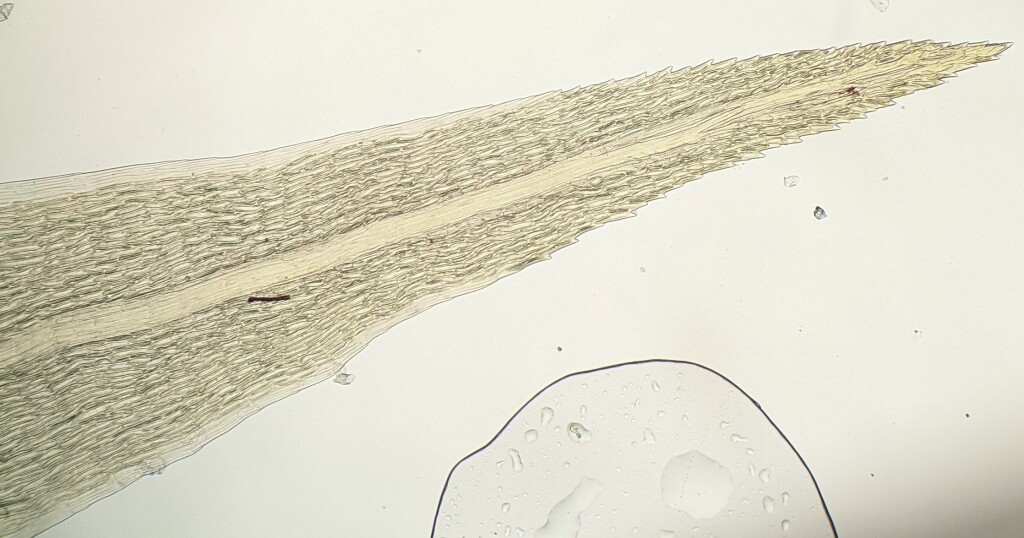Dicranoloma
Dioicous, almost always pseudoautoicous, with male plants almost always dwarfed and growing among stem tomentum of female plants. Asexual propagules usually absent, rarely reproducing by rhizoidal gemmae or leaf tips. Turves or cushions on soil, rocks, logs or tree bases. Leaves arranged around the stem, facing all directions, monomorphic, falcate-secund, erect- or wide-spreading when moist, hardly altered or with twisted apices or slightly flexuose when dry; apex usually acuminate, sometimes subulate, rarely obtuse (not in Victoria), sometimes fragile and missing; costa subpercurrent to long-excurrent, rarely to 2/3 leaf length (not in Victoria); margins entire (not in Victoria) or serrulate to serrate toward apex, with a border of more elongate hyaline cells extending a quarter of leaf length to near apex, or border sometimes ill-defined or rarely absent (not in Victoria); laminal cells in apical half oblate or isodiametric to linear, smooth; cells in basal half elongate to linear, smooth; alar cells well-differentiated, 1-stratose, quadrate, polygonal or rectangular, inflated or not, with brown, yellowish-brown or colourless walls, forming more or less triangular patches separated from costa. Acrocarpous. Sporophytes solitary or multiple per perichaetium. Capsules emergent (not in Victoria) or exserted. Calyptra cucullate, smooth, glabrous. Operculum obliquely-rostrate from conic base. Peristome teeth 16, asymmetrically bifid in apical half.
Around 40 species in southern South America, southern Africa, Madagascar, and south-east Asia through to the tropical to subantarctic Pacific, most diverse in Malesia, Australasia and the islands of the south-west Pacific (Klazenga 2012); seven species in Victoria.
The distinction of Dicranoloma from Dicranum has been long-debated and in cladistic analyses of morphological characters, Dicranoloma is placed within Dicranum (Klazenga 1999). However, phylogenetic analyses of chloroplast (La Farge et al. 2002) and combined chloroplast and nuclear DNA sequence datasets (Stech et al. 2006) resolve the two genera as separate lineages and Dicranoloma can be distinguished from Dicranum by the presence of a hyaline border in the vast majority of its species and by its entirely 1-stratose alar patch, which is almost always bistratose, at least in places, in Dicranum (Klazenga 1999).
 Spinning
SpinningKlazenga, N. (1999). A revision of the Malesian species of Dicranoloma (Dicranaceae, Musci). Journal of the Hattori Botanical Laboratory 87: 1–130.
Klazenga, N. (2003). A revision of the Australasian species of Dicranoloma (Bryophyta, Dicranaceae). Australalian Systematic Botany 16: 427–471.
Klazenga, N. (2012). Australian Mosses Online. 35. Leucobryaceae: Campylopus. http://www.anbg.gov.au/abrs/Mosses_online/Leucobryaceae_Campylopus.pdf.
La Farge, C.; Shaw, A.J.; Vitt, D.H. (2002). The circumscription of the Dicranaceae (Bryopsida) based on the chloroplast regions trnL-trnF and rps4. Systematic Botany 27: 435–452.
Milne, J. (2001). Reproductive biology of three Australian species of Dicranoloma (Bryopsida, Dicranaceae): sexual reproduction and phenology 104 (3): .. The Bryologist 104(3): 440–452.
Stech, M.; Pfeiffer, T.; Frey, W. (2006). Molecular relationships and divergence of Palaeoaustral Dicranoloma species (Dicranaceae, Bryopsida). Studies in Austral temperate rainforest bryophytes. Journal of the Hattori Botanical Laboratory 100: 451–464.




